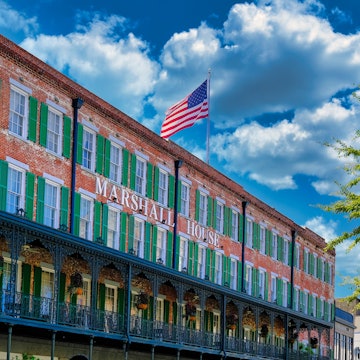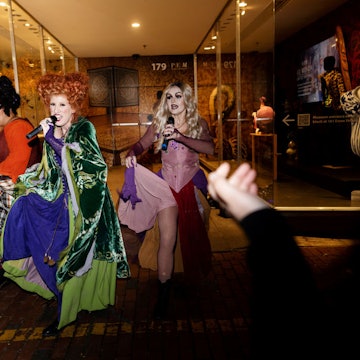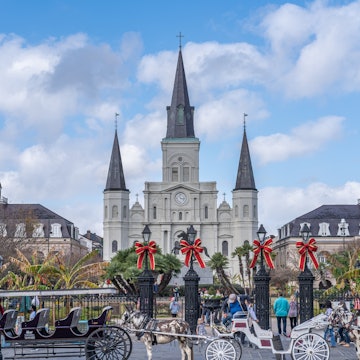
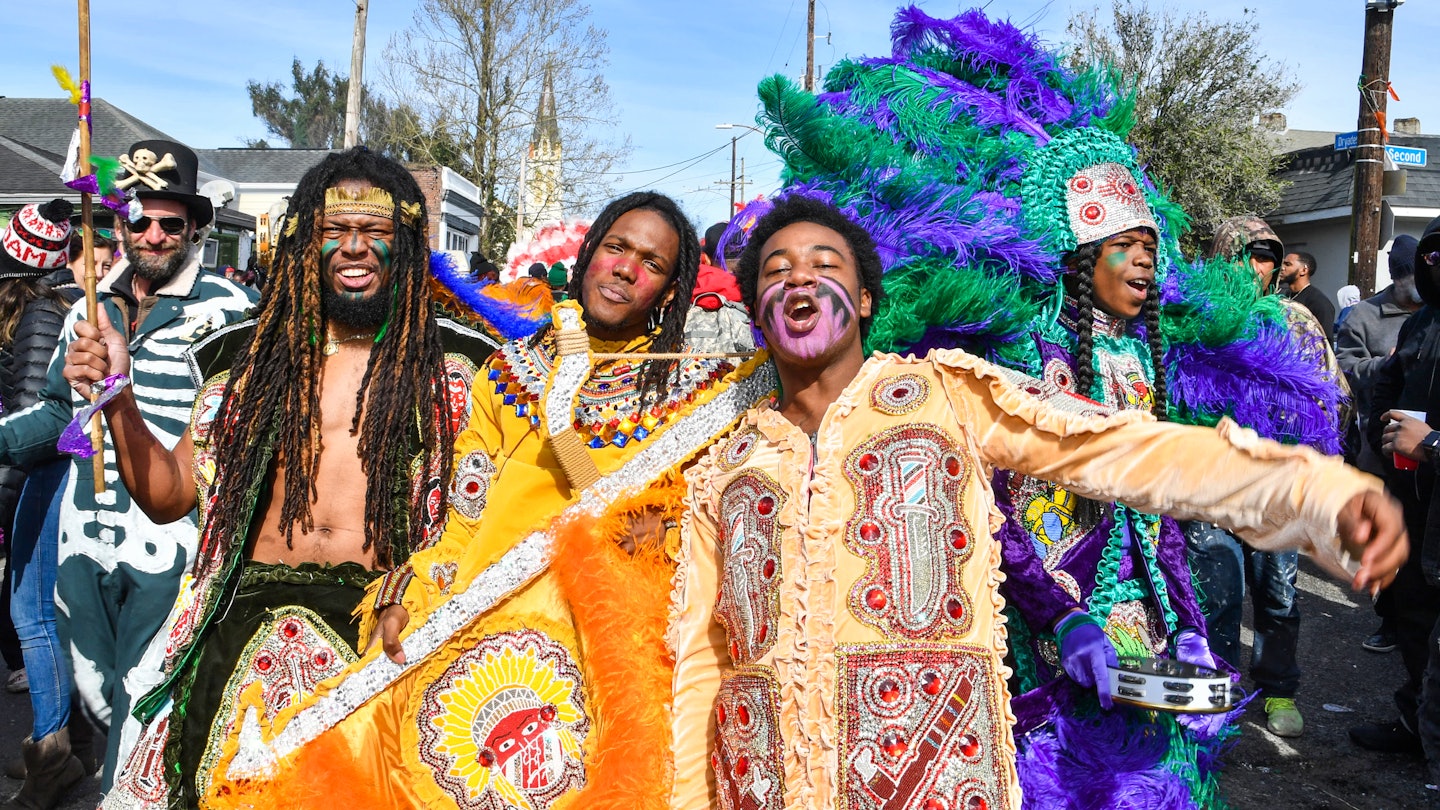
Lawrence Boudreaux, Marwan Pleasant, Jwan Boudreaux and Nigel Pleasant of the Golden Eagles Mardi Gras Indians face off with another tribe. Erika Goldring/Getty Images
It's colorful, chaotic and deeply engrained in the soul of New Orleans. Mardi Gras is undoubtedly the city's most epic event. So, how do you make the most of your time at this iconic festival?
Here's everything you need to know about doing Mardi Gras right.
What is Mardi Gras?
Mardi Gras – French for Fat Tuesday – marks the end of the Carnival season, a roughly two-and-a-half-week period of revelry that precedes the Christian holidays of Ash Wednesday and Lent. The next festival begins on January 6, 2025, running up to Mardi Gras on March 4, and New Orleans is famous for its celebrations, bringing in people from around the world to join in the party.
Much of Carnival is marked by parades, from small groups of friends to multi-mile processions of professionally built floats. The parades and their associated fanfare increase in frequency as Carnival goes on, reaching a fever pitch about five days before Fat Tuesday, culminating in pure debauched revelry on Mardi Gras day.
You haven’t done Mardi Gras unless you….
Do a parade. Either watch one or walk in one. Luckily, both are easy. Parades regularly roll down a set route through uptown New Orleans via St Charles Avenue. These are the bigger mainline parades, organized by local social clubs known as "krewes."
Another part of Mardi Gras is less formal, more DIY parades. These "walking krewes" throw participatory parades anyone can roll with – the biggest is the Society of Saint Anne, which marches down Burgundy St in the Bywater to the French Quarter and the Mississippi River, where they bid farewell to the previous years and departed loved ones.
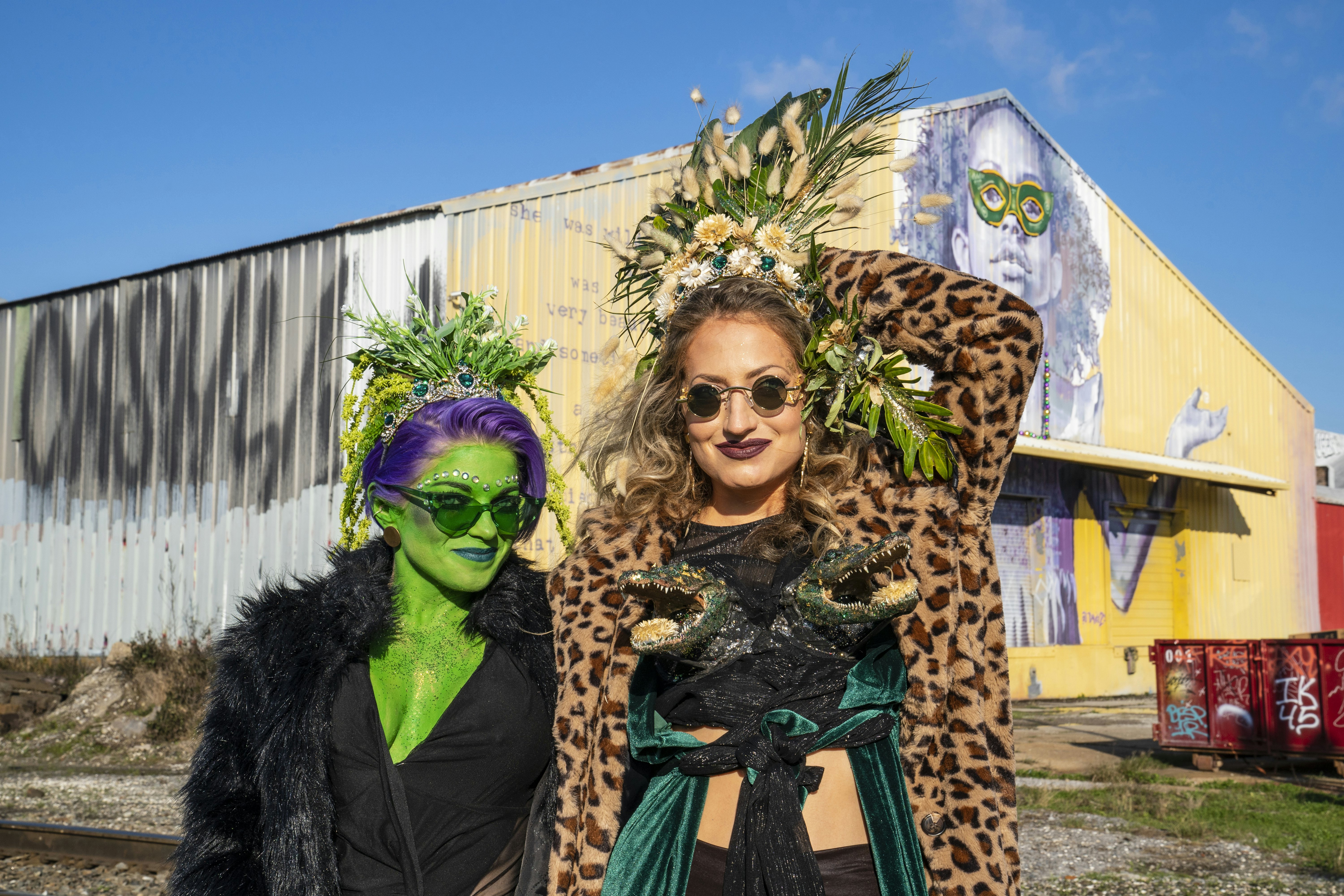
What do I need to pack?
Layers! Mardi Gras falls in February or March, so the weather might be balmy, or it might be freezing. Also, a bag for "throws" (the trinkets people toss from parade floats like coins, beads, toys and more), sunscreen, sunglasses, and comfortable shoes for walking.
Finally, but perhaps most importantly, bring a costume. Or be prepared to make one while you're here. New Orleanians like to have fun, but people take "masking," or costuming, seriously. Nothing will make you look more like a timid first-timer than trying to join a walking parade without a costume, as these parades attract a more bohemian crowd. Also: some kind of pain relief for a hangover is probably a good idea.
What should I wear?
What goes into a good Mardi Gras costume? Usually, a ton of glitter. Really, a Mardi Gras costume can be anything you want – it just needs to be bright, noticeable, and ideally clever. Try and pick a costume that can be coupled with good, comfortable shoes (there’s a lot of walking during Mardi Gras, even if you’re not in a parade).
Another key tip: choose a costume that allows you to easily use the facilities when needed. Bathroom lines will be long, and people can get impatient.
Mardis Gras etiquette tips
Don't grab parade throws ahead of kids
Parade throws are really meant for kids — and there are lots of kids on parade routes — so if you see children near you, be a hero and give them what you catch.
Don’t try and park too close to a parade route
This isn’t an etiquette thing; it’s just a nightmare trying to find parking close to, or drive away from, a crowded parade. We recommend renting bicycles if you want a quick, efficient means of getting around.
Do be creative
With your clothes, with your celebrations...this is meant to be fun!
Do let yourself run wild
Er, within reason.
Do ask for permission
When possible, ask someone for permission when taking photos of their costume. This goes double for Mardi Gras Indians (see below for more).

Celebrate the local communities that are the soul of Mardi Gras
Go see Mardi Gras Indians, who represent a specifically African American take on masking that involves painstaking bead and feather sewing for their costumes, and rhythmic call-and-response and singing with West African roots during parades.
There are some 40 "tribes," representing different neighborhoods or social circles, each dominated by a hierarchy of masked "Big Chiefs," "Flag Boys" and "Spy Boys" (among others), who parade wearing costumes that can weigh in excess of 150 pounds (70kg).
Indians are manifestations of the city's backstreet, a term for the grassroots-grown Black cultural milieu that truly makes New Orleans unique. Indians mask and parade in Black neighborhoods – the tradition is partially born out of a need to reclaim Mardi Gras for the Black community. They are iconic symbols of Mardi Gras and frequent subjects of documentary photography and videography, so they're used to being filmed — but it's still polite to ask.
If you want to see Mardi Gras Indians chanting and parading on Fat Tuesday, head to streets like St Bernard Ave, or the intersection of Claiborne Ave and Orleans Ave. Keep a respectful distance, read the room, and flow with the crowd’s energy when it comes to moving around.
What’s a secret Mardi Gras location?
It’s no secret, per se, but in many ways, Mardi Gras begins in the heart of the Tremé, one of the nation’s oldest Black neighborhoods. In the street in front of St Augustine’s Church, members of African American parading groups like the Babydolls, the North Side Skull & Bones (who dress as skeletons to represent the mortality that comes hand-in-hand with revelry) and some Mardi Gras Indians, gather around 5am to greet the dawn and kick Mardi Gras off.

Are children welcome at Mardi Gras?
Yes! Contrary to popular perception, Mardi Gras is largely a family holiday. People get wild in the French Quarter, but you’ll see families out enjoying the day all across the city. Kids love costumes!
What neighborhood should I stay in?
New Orleans has a neighborhood for every kind of traveler. If you want to see big parades with lots of floats, stay Uptown, or in the Garden District. If you want to party, stay in the French Quarter or CBD. If you want to join smaller DIY walking krewes, stay in the Bywater or Faubourg Marigny.
How do I get to Mardi Gras?
Mardi Gras occurs all over Louisiana, although New Orleans’ celebration is the most famous. Louis Armstrong International Airport (MSY) receives flights from around the world, but fair warning, tickets can get pretty expensive near Mardi Gras day.

What are the sustainability efforts and how can I help?
Every year, people throw out some 25 million pounds of beads. Usually, they’re made of cheap plastic, and all too often, they clog drainpipes and sewer grates. Don’t buy bog-standard cheap plastic beads. If you get some, donate them to the Arc of Greater New Orleans, which recycles throws. And do an internet search of "sustainable Mardi Gras beads" to bring up several retailers offering throws that don’t just trash the city.
Local tip: “When in Rome, don’t do as the Romans. We have a bad habit of littering in New Orleans that only gets worse during Mardi Gras. Have a good time, and please throw trash away responsibly — a cleaner city makes for a better Carnival.” – Mike Robertshaw, member of Krewe Delusion.
What can I do after Mardi Gras?
Rest? You’ll probably need it! A bit of nature never did anyone wrong after hard partying, and to this end, you could drive about an hour south of town to the Barataria Preserve, where an easy boardwalk path extends out over the bayou and swamps.
You can’t miss...
Having a slice of king cake before you leave. This seasonal treat is a roll of twisted cinnamon-infused dough, often accompanied by a filling — cream cheese is the most common, but you can also find Bavarian cream, pecan praline, and other goodies. King cake is the food of the Gods, both because it tastes good and because eating too much will hasten the process of meeting your maker.
Here are some recommendations on where to eat and drink while you're here.

I missed out on this year — how do I start planning for next year?
You’ll want to make hotel and restaurant reservations at least three months out, if not more. Because Mardi Gras’s timeline is based on the Catholic calendar, the actual date is a moving target that falls in February or March; check out future dates here.
Pop culture prep work
Best Mardi Gras TV Show
Treme, Season 1, Episode 8: All On a Mardi Gras Day
"Treme" was David Simon’s love letter to New Orleans, its people, and its culture. "All On a Mardi Gras Day" may be the best-fictionalized depiction of the holiday on film, an hour-long parade (sorry...) of every element of Mardi Gras celebration, from St Charles Avenue float parades to Mardi Gras Indians, as experienced by a hapless cast of misfits who let the sensory overload wash over and into their being — all as it should be, all on a Mardi Gras Day.
Best Mardi Gras music
Speaking of "All On a Mardi Gras Day," that’s an actual song, as performed by the Wild Magnolias – a Mardi Gras Indian tribe that doubles as a funk ensemble. There’s an entire genre of New Orleans music known as Carnival music that ranges from brass band favorites to funk to hip-hop; these playlists, put together by local music stewards WWOZ, aren’t comprehensive, but they’re a good start.









